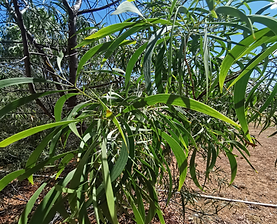
Wedderburn Conservation Management Network
Protecting Biodiversity - Our Flagship Species - Malleefowl Leipoa ocellata

Pete's Plant Pick
Plant of the Season




Hickory Wattle, or Lightwood.
- Acacia Implexa
Acacia Lightwood (Acacia implexa), commonly known as Hickory Wattle, is a vigorous, long-lived, and fast-growing native Australian tree. As one of the largest wattles, it is renowned for its striking foliage, resilience, and significant ecological benefits.
Appearance and Growth
Acacia implexa is a small to medium-sized tree that can reach up to 15 meters in height under optimal conditions but typically grows to around 5–6 meters in the local area. As it matures, it develops a distinctive twisted and gnarled trunk, giving it a unique, sculptural form. The bark is rough, greyish-brown, and marked with longitudinal fissures. Instead of true leaves, the tree has phyllodes—elongated, narrow, and slightly curved leaf-like structures—measuring 7–20 cm in length and 6–25 mm in width, with prominent longitudinal veins. These phyllodes are usually bright green but may sometimes take on a bluish tint, giving the tree a graceful appearance.
To identify Acacia implexa, look for its most distinctive feature: twisted, coiled seed pods that resemble tangled bird’s nests. Its rough, greyish bark further adds to its rugged character.
Flowering Season
showcasing creamy-white to pale yellow flowers arranged in spherical clusters. Blooming from late winter to early summer, these striking blossoms contrast beautifully with the green foliage. Beyond their visual appeal, the flowers serve as a valuable nectar source for pollinators such as bees, contributing to a thriving and balanced ecosystem.
Environmental Considerations
This wattle plays a vital role in its native ecosystem by providing food and shelter for various wildlife species. As a nitrogen-fixing plant, it enhances soil fertility by converting atmospheric nitrogen into a usable form, benefiting surrounding vegetation. This process supports biodiversity, promotes healthier plant communities, and improves soil health. Additionally, Hickory Wattle contributes to habitat stability, making it an essential component of its environment.
Uses
Acacia implexa serves multiple practical purposes. Indigenous Australians have traditionally used its strong, durable wood to craft tools and weapons. Its bark is rich in tannins, making it useful for leather tanning. Additionally, the tree is commonly planted for land rehabilitation and erosion control, as its deep root system helps stabilize the soil.
Location and Soil Preferences
Acacia implexa is highly adaptable to various soil types, including clay and loamy soils, and its drought resistance makes it well-suited for xeriscaping (a water-wise landscaping approach). Some ancient specimens of this species can be found on the slopes of The Granites (Mount Egbert, Ngarri) and Mount Korong, standing as enduring examples of its resilience and longevity.
Care and Maintenance
A hardy tree that thrives in full sun and well-drained soil, tolerating both drought and urban pollution once established. It requires minimal pruning, fertilization, and pest control, making it a low-maintenance option for various landscapes.
Photos,
Peter Goegan , Euclid